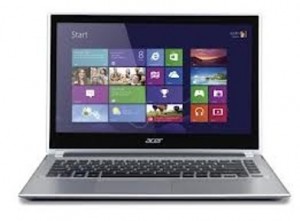Yesterday we posted about computing for seniors. Well, today we headed out and gave some assistance to the prospective purchaser. Things worked out better than we thought and we ended up with a very good deal on a 14″ Acer touchscreen laptop. It had good specs (8 gigs of ram and a healthy sized hard drive, Windows 8) and seemed to be just the right size. We weren’t looking for a desktop replacement, but a Chromebook would have been far too small. In addition to the computer, we picked up a small wireless all-in-one inkjet printer by HP. Total for everything, including 500 sheets of paper and a spare black ink cartridge was less than $700.00, proving that you don’t have to break the bank to get online.

Once everything was settled, we started to consider the setup process. As you may know, there are a few things that you should do before heading to Google or Youtube. Here’s what we’d suggest, step by step:
1. All new computers come with what we call ‘bloatware’. Bloatware is software that is loaded onto the computer by the manufacturer in the hopes that you might actually buy some of it. This usually includes various versions of antivirus software, Internet ‘safety’ kits as well as games and, usually, a free-ish version of Microsoft Office. Our first step would be to eliminate as much of this bloatware as possible, starting with the antivirus applications.
Microsoft has its own antivirus application that’s free, believe it or not. It’s called Microsoft Security Essentials. Click on the words to get it. Once you install it, you’re just as safe as with any of the other professional (meaning pay) software. Windows already has a firewall built into it so that’s all you need. Make sure you update the virus database at least once a month and either scan your computer on a weekly basis or set up a schedule for scanning.
2. Every ISP lets you use their email for free. Well, we’re not fans of ISP email programs, preferring free online options such as Outlook or Gmail. Outlook has pretty much dropped the ‘hotmail’ domain name, switching to ‘live’ instead, so you don’t have to worry about being old-fashioned. Gmail is an option too but Windows 8 seems tied to all things Microsoft and Outlook might be your best bet. We have both but we use Outlook much more often.
Why use a free email service? Mainly because you will always have that address, even if you change ISPs. These online services have strong anti-malware checking built-in to the site. You have to go out of your way to get something nasty on your computer if you use one of the free sites. Lastly, your email stays on their site, not on your computer. You won’t lose your messages or photos if your computer crashes. They’re online so they’re safe.
TIP: Don’t confuse the Outlook application that is on your computer with the outlook.com site. The software that is on your computer is obscure, to say the least, and is very confusing to use. Yes, you can access your email from it but it’s much more difficult to understand. Head to outlook.com, sign up for a free account and you’re away.
TIP: Make your username as unusual as possible. If your name is Elsa, for instance, choose something like elsa_elsa_85. Why? Because spammers make up names and spam them automatically. If you use some arcane username, more than likely the spammers will never find you. We have a couple of email accounts that get NO spam at all. Others, with more easily imitated names, get spam every day.
TIP: Don’t get hooked into extra-cost warranties or anything to do with Microsoft Office. There is usually a free version of Microsoft Word on any Windows computer and, if not, there is always Libre Office , a totally free, open-source alternative. Buy the computer, that’s it, no matter what the salesman says. If they get too persistent, just walk out of the store.
That’s enough for now. Next time we’ll look at what software we would install on a new computer. If you have questions or suggestions or comments, feel free to use the form below to contact us.
Thanks for reading!
